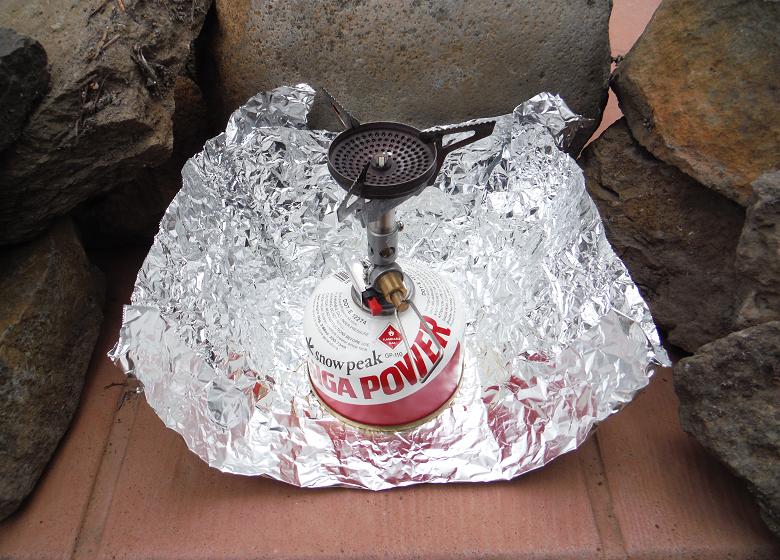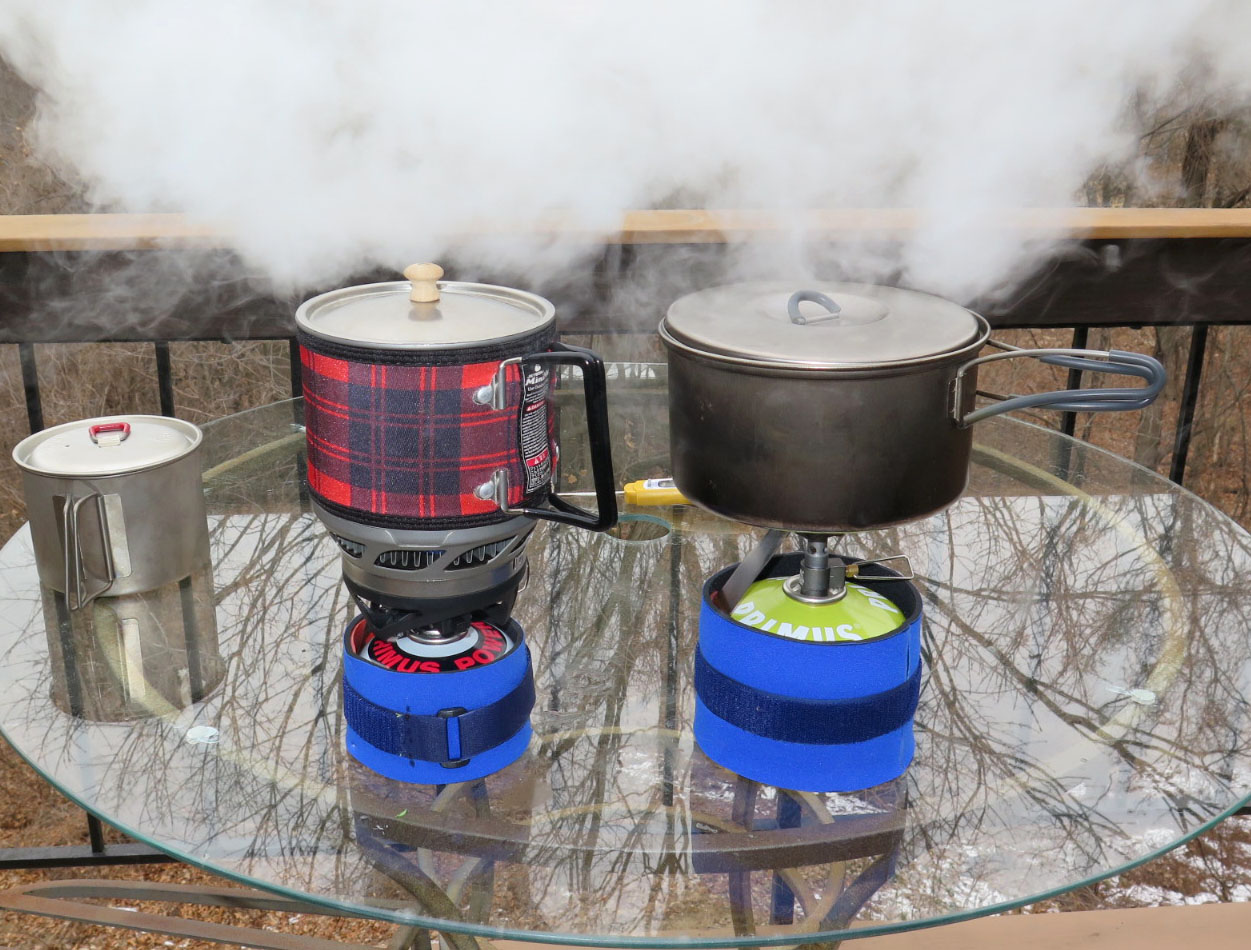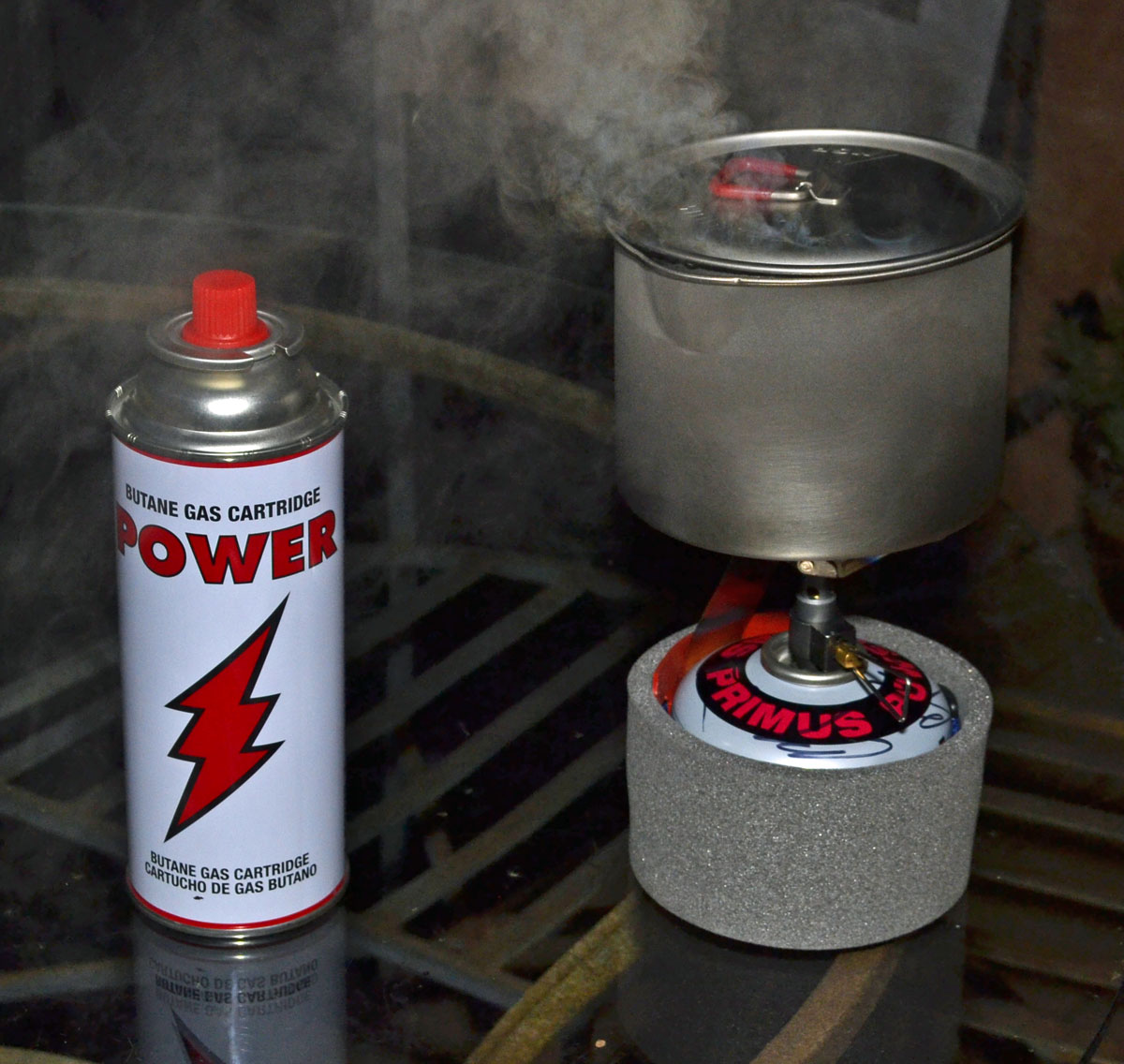Topic
cheap butane canisters
Forum Posting
A Membership is required to post in the forums. Login or become a member to post in the member forums!
Home › Forums › Gear Forums › Gear (General) › cheap butane canisters
- This topic has 53 replies, 6 voices, and was last updated 8 years, 1 month ago by
 Bob Moulder.
Bob Moulder.
-
AuthorPosts
-
Nov 18, 2016 at 5:57 pm #3436301
“there is a steady supply of once-used canisters in many trail head trash cans.”
Good idea, Bob. I bet if you set up a box marked, “Recycle your empty butane canisters here” and returned in a week, you’d have a bunch of empties and near-empties to work with.
Nov 18, 2016 at 6:10 pm #3436304Um, well, yeah, kinda.
But inspect the heck out of them. I picked one up at a trail camp once. As I filled it with butane… it quickly started hissing. The bottom seam was bad some how. Good thing I don’t smoke. Probably why it was abandoned in the first place.
I get plenty from friends and such. I mean how many 110 g canisters do you need at one time anyway? Fill ’em half a dozen times or so, then recycle them — all the while collecting replacements from known sources. Nobody else is cheap enough, er, thrifty enough to do their own refilling, so it’s not like you’re fighting over who gets the empties. People are glad they’re not going into the land fill.
HJ
Nov 18, 2016 at 9:37 pm #3436337No doubt, those of us who refill them are very, very few in number… plenty of empties available.
As a test, I have a Primus 110g canister that I have refilled 18 times thus far and I plan to continue doing so just to see how many cycles it takes for the Lindal valve to wear out. That’s the one I use for almost all my tests at home. I have a couple of other 110g and 230g canisters with far fewer cycles that I take for actual backpacking trips.
And I always keep the plastic caps on the canisters and the stove in a little bag to help keep tiny debris out of the valves, jets, etc… those are some awfully small orifices and one teensy speck of schmutz could really mess up dinner plans.
Nov 18, 2016 at 9:46 pm #3436338“those of us who refill them are very, very few in number”
And fewer still, with any mistake we make!
“I always keep the plastic caps on the canisters”
Me, too. The thread on the canister is semi-disposable, but I worry about sand and grit getting into the female thread on my stove(s).
Nov 19, 2016 at 5:22 am #3436356And fewer still, with any mistake we make!
Ha, well fortunately it is quite safe since I’m refilling with straight n-butane and not trying to replicate factory blends nor attempting to “stuff” a higher percentage of propane into a custom blend. My refilled canisters end up being safer than the factory ones.
Of course there are the Darwin Award contenders who might try to do all the above while smoking a doob, or leave a 50% propane blend in a hot car, or some other form of nit-wittiness that the normal person could not fathom.
Nov 19, 2016 at 7:34 am #3436366there are old refillers
and bold refillers
but no old bold refillers
actually, I don’t think it’s that much more dangerous than screwing and unscrewing your stove as long as you weigh it
Nov 19, 2016 at 10:01 am #3436377actually, I don’t think it’s that much more dangerous than screwing and unscrewing your stove as long as you weigh it
That’s about right. With an appropriate adapter there isn’t much that can go wrong, Darwin Award wannabes notwithstanding. ;^)
Nov 19, 2016 at 12:46 pm #3436391The thread on the canister is semi-disposable, but I worry about sand and grit getting into the female thread on my stove(s).
I find the half-formed jagged steel thread on the canister lasts longer than the brass thread on the stove. Sigh.
Cheers
Nov 29, 2016 at 5:05 pm #3437863I tried on a trip
I tried some MSR Butane (N Butane < 5%) which worked fine at 25 F, but it was a little slow. I could probably use this down to 20 F.
I tried the Max cheap butane that’s $1.25 for 8 ounces at the Korean grocer and used the adapter to put into a regular canister. At 32 F it took 4.5 minutes to boil 16 ounces of water. It normally takes 3 minutes. I could probably use this down to 30 F so it contains some mixture of N and Iso butane (and other gases).
So, the cheap butane requires about 10 F warmer to work.
I used a foil reflector with the cheap butane and it worked fine at 25 F:

12″ x 10″, 0.15 oz
I’m just guessing the foil will lower the temperature limit from 30 F to 20 F for the cheap butane, or from 20 F to 10 F using the expensive MSR butane.
maybe the Moulder Strip works about the same as the foil?
Nov 30, 2016 at 10:56 pm #3438079I wouldn’t “set my watch” by the percentages of the constituent gases in canisters. I’m sure there’s going to be some variance. You might be cutting it a little close, particularly on the restaurant type butane canisters.
There are two strategies:
1. Choose a gas blend that has a vaporization point/boiling point 20 Fahrenheit/10 Celsius degrees lower than the expected temperatures you expect to encounter. You should have good pressure if you stay within these parameters provided that the canister doesn’t cool too much from within due to, say, an extended burn.
2. Warm the gas canister in some way.And of course you could do a combination of the two.
HJ
Dec 1, 2016 at 4:25 am #3438090I’m just guessing the foil will lower the temperature limit from 30 F to 20 F for the cheap butane, or from 20 F to 10 F using the expensive MSR butane.
maybe the Moulder Strip works about the same as the foil?
Nope.
With my HX strip design I can easily operate my stoves down to -5°F on straight N-butane, and probably much colder but that’s the coldest I’ve tested. And the stove runs at full output until the last molecule of fuel is consumed. The issue of fuel blend is moot.
Photo: Running on straight N-butane at -5°F (MiniMo, left) and Primus “summer” gas (BRS-3000T, right)
 Dec 1, 2016 at 7:46 am #3438099
Dec 1, 2016 at 7:46 am #3438099How does it start? If the canister is warm enough for enough pressure for a little fuel to get out and start burning. and then get that heat going back to the canister, it’ll start working good.
For cheap butane, at maybe 25 F, there’s no pressure, and for the expensive butane, maybe it’s 15 F. Below that, if you open the valve, nothing comes out.
Maybe there’s enough propane in the mix to get it going.
Either a reflector or a strip share this problem.
Dec 1, 2016 at 8:04 am #3438101With straight N-butane the canister needs some pre-warming to get the thermal feedback loop started. N-butane vapor temp is 31°F.
However, I did a short overnight trip a couple of days ago (for testing the HX strip and also a quilt modification) and although the stove/canister had been out all night I was able to start and run the BRS stove using N-butane at 27°F with no pre-warming.
How did I do this? I discovered (or maybe I read elsewhere and forgot) another little trick which I had been thinking about: I shook the canister vigorously for a few seconds before lighting. This mechanical action caused enough vaporization of the fuel to start the stove. It burned weakly, but it was enough to get the thermal feedback going.
With commercial mixes containing propane—and depending upon the fuel level and amount of propane remaining—the stove will start and run full bore immediately on a full or nearly (80%) full canister, or when the fuel level is low, the initial flame can be weak but the output will come up to full power within a couple of minutes when the thermal feedback loop is established.
Dec 1, 2016 at 8:34 am #3438105I suspect your mix is not straight N butane, but a mixture that includes iso, propane, and other stuff. If it’s straight N butane, at 31 F, there will be zero pressure and the stove won’t start even feebly. Isobutane is 11 F, so you must have the equivalent of 25% iso, and 75% N. That’s about what the stuff I got is too – at 25 F I could get a canister going but barely.
“…the stove will start and run full bore immediately on a full or nearly (80%) full canister…”
That’s the problem with propane, if it’s cold, and you run it a while, by the time the canister is mostly empty, there won’t be much propane left. But if I have to, for example, start with a full canister and only use it til it’s half full, then the propane would help.
I’ve tried shaking it and I wasn’t sure if that helped.
Dec 1, 2016 at 8:57 am #3438108Well this is the stuff. If there’s any propane (or other gas) in there it’s only a trace amount. This photo was made during the the very first test at 13°F and I was quite surprised that it even worked. Also worked extremely well with a SP Giga and a JB MiniMo.

When using this setup it literally doesn’t matter what fuel you’re using. No propane?…. No problem.
Dec 1, 2016 at 11:06 am #3438125Bob,
Do you have a close up photo of the strip where it enters the flame? And is it aluminum?
How do you attach it to the side of the canister? JB Weld? Duct tape?
HJ
Dec 1, 2016 at 12:59 pm #3438152I really doubt that the stuff in a cheap can labeled ‘butane’ will be pure n-butane. Not the commercial stuff anyhow. Could be quite a mix, with some iso-butane and even some propane. No harm done.
Shaking – I wonder whether just holding the canister warms it up a tiny bit – enough to vaporise some of the splashes where they hit a warmed-up bit of the metal? That happens with sunlight on big LPG bottles too.
These are not ‘competing’ technologies: they all are tricks of the trade we can use to get a warm meal. Bob’s HX strip works well, but some people, including climbers, had already been doing that for years before it was mentioned here. I even have a photo of some Norwegian skiers sitting the canister at the end of its hose on the lid on top of the cooking pot. Now that sounds a bit risky to me!
Cheers
Dec 1, 2016 at 1:16 pm #3438155The definitive HX strip thread.
It’s rather long-ish, but reading only the first 2 and last 2-3 pages gets it from concept to current state.
In a nutshell, the strip is copper (20mil x 1″ width) and it is attached with Velcro that is insulated with a patch of sheet silicone. In its current state, the silicone insulator, Velcro cinch strap and neoprene cozy are now integrated into one piece.
Yes, people have been using heat shunts for a good long time. But with the devil being in the details and all that, nobody did it anything like this before to obtain the ease of use, safety and consistency of results.
Dec 1, 2016 at 2:34 pm #3438167Shaking – I wonder whether just holding the canister warms it up a tiny bit – enough to vaporise some of the splashes where they hit a warmed-up bit of the metal? That happens with sunlight on big LPG bottles too.
This time it had the 3mm neoprene cozy on it and I was wearing some thin liner gloves so I’m pretty sure it wasn’t heat from my hand. So I think there’s something to it, OR there are other variables to consider. It had been sitting outside for more than 12 hrs so it is safe to assume that it had settled to ambient temp (determined by my Casio watch, which is pretty accurate in fact).
Dec 1, 2016 at 3:13 pm #3438178Hi Bob
Interesting. Deep thought needed.
Cheers
Dec 1, 2016 at 5:48 pm #3438213Well, shaking the canister does indeed help with pressure. I mentioned this a while ago as one way to get a stove going. I do it all the time to get one of Rogers stoves to fire up in 20F weather. It is actually easy enough to do even with the remote stove burning. It is ONLY a temporary fix, though. The heat strip needs to start warming up in 5-10 seconds.
Just as you can supercool water to well below the freezing point. Any winter steelhead fisherman will tell you that RUNNING water will NOT freeze even if it is cold enough to form ice as it leaves the riffle. Or superheating water well beyond the boiling point. Throw a cup of water into your mic. Nuking it too long can make it dangerous to drop in a tea bag. This is a well known phenomenon in chemistry. Molecules have mass, so, they also have inertia. Shaking the can will add inertia to the molecules. Same as gyroscopic action, mass is spinning whose inertia lets it seem to defy gravity.
By shaking a canister it forces more gaseous state molecules to temporarily exist within the can. This equates with increased pressure. Temporarily, the fuel will actually become a bit cooler, but have more pressure. It will take about 10-15 seconds to re-stabilize at the normal temperature/pressure due to surface tensions on the liquid portion of the fuel, even if they are weak. Anyway, there is a distinct advantage to shaking a can. In this case, I suspect that the mechanical movement first shows up as heat in the molecules in the can. The small, almost arisolized, fuel globules have a higher surface area so they tend to disassociate to a gas easier than just a smooth surface of a stationary can. This will cause a large number of molecules to become gaseous, but lowering the actual temperature of the fuel as it settles back in the can. The surface tension will resist the gas from adsorption into the liquid state. So, you get about 3-15 seconds of usable pressure before it restabilizes.
As Bob was saying, this may be enough to get some sort of feedback going. The trick is trapping enough heat initially to warm more fuel. If the flame starts to die out, you can continue to shake it. Very easy with Rogers Stove or with Bob’s Strip. Continuing to heat is a bit more difficult when using Bob’s Strip on a topper due to the larger sized expansion chamber (valve assembly vs can+valve assembly) acting as a heat sink. Though you might get some sputtering and yellow flames with either.
Dec 1, 2016 at 6:06 pm #3438214Blimey. The things you learn on BPL!
Thank you James (and Bob too). I had NOT considered transient effects such as you have outlined. I am not sure I am going to recommend such shaking to all and sundry – the potential for disaster is certainly there when done during cooking, but it is worth knowing about that for getting the stove started.
Cheers
Dec 1, 2016 at 6:33 pm #3438220Ha, rather disastrous if someone tried it while cooking! I hope people have more sense than that…
Dec 1, 2016 at 8:31 pm #3438227I hope people have more sense than that…
Yeah????
Cheers
Dec 1, 2016 at 9:26 pm #3438231James, thanks for the explanation and confirmation that I am not “seeing things”. ;^)
I am thinking the trick works at 27°F but probably wouldn’t work at all around 10°F, give or take, so starting with a fairly warm can or warming it with body heat or a Bic (David Thomas suggestion which I have used) will be necessary. I remember well my first night of testing at 13°F when I intentionally left the valve open all night after completing some stove runs. I didn’t weigh it, but I don’t think it lost any fuel overnight because the outside air remained very cold.
But I will try it again when it gets very cold, and if the long-range forecasts are right we’re due for a much better (colder and snowier) winter than we had last year. We shall see.
-
AuthorPosts
- You must be logged in to reply to this topic.
Forum Posting
A Membership is required to post in the forums. Login or become a member to post in the member forums!
Our Community Posts are Moderated
Backpacking Light community posts are moderated and here to foster helpful and positive discussions about lightweight backpacking. Please be mindful of our values and boundaries and review our Community Guidelines prior to posting.
Get the Newsletter
Gear Research & Discovery Tools
- Browse our curated Gear Shop
- See the latest Gear Deals and Sales
- Our Recommendations
- Search for Gear on Sale with the Gear Finder
- Used Gear Swap
- Member Gear Reviews and BPL Gear Review Articles
- Browse by Gear Type or Brand.






